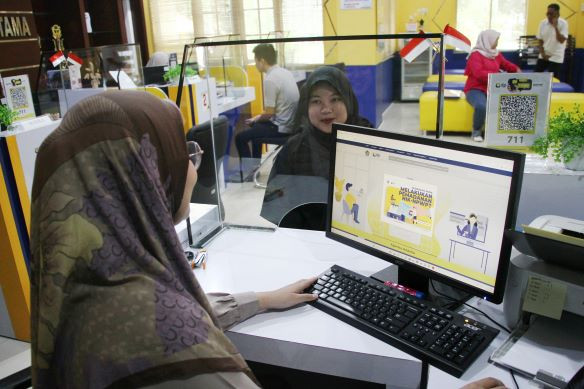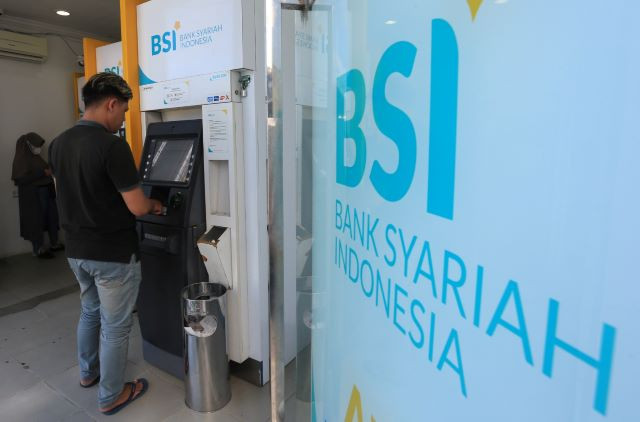Indonesia on the cusp of big changes in overseas investment trends
Despite very favorable demographics and natural resources, Indonesia has lagged in attracting FDI.
Change Size
 Going public: E-commerce giant PT Bukalapak.com marks its listing on the Indonesia Stock Exchange through an initial public offering (IPO) in a virtual conference on Friday. Bukalapak is the 28th company to go public this year. (Courtesy of/Bukalapak)
Going public: E-commerce giant PT Bukalapak.com marks its listing on the Indonesia Stock Exchange through an initial public offering (IPO) in a virtual conference on Friday. Bukalapak is the 28th company to go public this year. (Courtesy of/Bukalapak)
I
ndonesia could be on the cusp of significant changes in overseas investment into the country. We anticipate growing foreign interest not only in the stock market, but also in direct manufacturing capacity, and infrastructure financing. A significant change in the flow picture into Indonesia could be expected in the coming years.
We think Indonesia is poised to transition from being a magnet for debt capital to being an attractive destination for equity capital. Technology initial public offerings (IPOs) an improving foreign direct investment (FDI) climate and the creation of a credible vehicle for infrastructure investment will all be important catalysts.
A shift from debt to equity capital. As a current account deficit country, Indonesia remains dependent on foreign sources of capital financing for her investment needs.
Historically, Indonesia has relied heavily on overseas foreign exchange (FX) borrowing and foreign purchases of local bonds. Foreign capital has largely gone into Indonesian debt securities. Indeed, Indonesia’s external debt liabilities are close to four times as large as her portfolio equity liabilities. Foreigners owned over 40 percent of government bonds at the peak last year, while foreign inflows into equities have been largely absent in the past decade.
Direct investment by foreign companies in Indonesia has been a third of that received by Vietnam in recent years, when measured as a percentage of each country’s GDP (World Bank data). And funding for Indonesia’s large infrastructure needs have largely come from the government and state owned enterprises, which have been taking increasing amounts of debt onto their balance sheets to support this financing.
But change is now underway. We think more foreign money will flow into Indonesian equity holdings in the next few years, across publicly listed equities, direct stakes in company assets, and long-term investments in infrastructure.
These flows will be powered by three key drivers. First, the IPOs of Indonesia’s home-grown technology companies on the Indonesian stock exchange (IDX) is set to change the equity market’s composition and reinvigorate foreign interest. Second, the omnibus law on job creation is improving the landscape for FDI, particularly into labor-intensive manufacturing. Third, the creation of Indonesia Investment Authority (INA) should help attract long-term institutional capital for infrastructure projects.
These are all significant drivers in their own right. Together they could be a game-changer for Indonesia’s capital flow trends.
The Indonesian equity market has lagged behind regional peers in recent years. The market capitalization of Indonesian equities is currently the smallest of major Asian economies at just 46 percent of GDP, less than half the regional average. Many Indonesian companies have chosen to list overseas in the past and the Jakarta Stock Exchange Composite Index (JCI) is more heavily weighted towards “old-economy” stocks like financial and consumer staples.
But this could now change. Indonesia’s home-grown and maturing tech start-ups across e-commerce, mobile payments, ride-hailing and travel have shown a greater willingness to go public domestically.
A revision in IDX rules to allow companies that have yet to turn a profit to list is also playing an enabling role. Draft regulation to allow dual classes of shares with multiple voting rights could also give company founders greater comfort with going public at home.
The recent Bukalapak IPO, which is so far the largest in Indonesian history will likely mark a new chapter in the equity market’s evolution. If this is followed later in the year by GoTo, and other tech unicorns, it could start to change the sectoral composition of the equity market, making it more attractive for global participation.
The 2020 Job Creation Law could be a major catalyst for foreign direct investment. Despite very favorable demographics and natural resources, Indonesia has lagged in attracting FDI. This underperformance has arguably been because of a regulatory climate of onerous labor laws, and a complex licensing and tax regime. The omnibus Job Creation Law, which amended 76 laws in one sweep in October 2020, is tackling many of these difficulties.
Indonesia was still one of the most restrictive places for FDI in Asia in 2020, according to the Organisation for Economic Cooperation and Development. But progress is being made. The job creation law shifted Indonesia’s FDI governance from a negative investment list regime to a positive investment list one. This theoretically opens all sectors to 100 percent foreign investment unless specified elsewhere. Indonesia has established a new investment ministry, and designated a priority list of 245 sectors eligible for additional tax and energy incentives.
Indonesia is already breaking ground on its ambitions to become an electric vehicle and battery production hub. And other labor-intensive sources of manufacturing could be encouraged to set up here. INA will be an important vehicle for bringing in long-term infrastructure capital
Indonesia has identified an over US$400 billion infrastructure spending need over 2020-2024. The government has been supporting this requirement with increasing allocation from the annual budget, and state owned enterprises have been raising debt to fund key projects. But fiscal constraints and rising SOE indebtedness mean that alternative sources of capital from the private sector are now required. Indonesia’s new sovereign wealth fund has been created to help fulfil that objective.
We see the INA as a vehicle for foreign investors to invest in infrastructure projects alongside government committed capital, with the benefits of project diversification, reduced risks, monitoring and governance. The global search for alternative assets, higher returns and environmental, social and governance (ESG) thematic should all make this an appealing option to long-term institutional investors. INA has a bold target of $200 billion in fund commitments over the next 2-3 years.
Longer-term equity flows tend to be more stable, and less prone to reversal and hedging during times of global dollar stress than debt flows. They are thus a more desirable source of financing for Indonesia’s current account deficit, which could liberate the currency and monetary policy from bouts of volatility.
More stable, long-term sources of foreign flows could help steady, and possibly strengthen, the currency. This would be a key positive for Indonesian assets as concerns around FX volatility and unpredictable hedging costs would decline.
A stable currency will also help Bank Indonesia to continue supporting the recovery with accommodative policies, as the historical pressure to tighten monetary policy in response to bouts of FX stress could lessen.
***
The writer is a strategist at Deutsche Bank.









